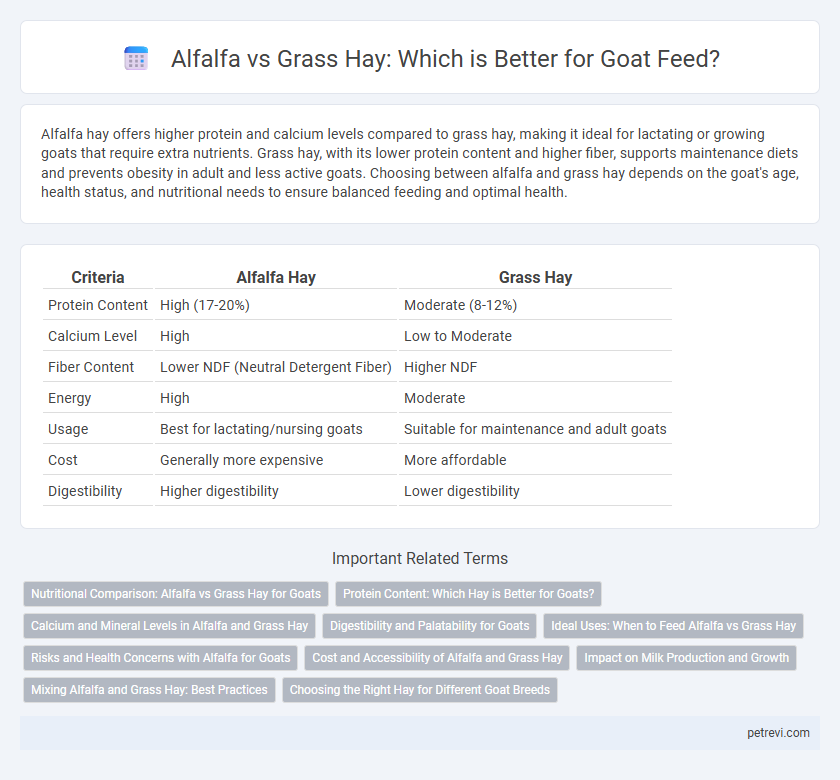Alfalfa hay offers higher protein and calcium levels compared to grass hay, making it ideal for lactating or growing goats that require extra nutrients. Grass hay, with its lower protein content and higher fiber, supports maintenance diets and prevents obesity in adult and less active goats. Choosing between alfalfa and grass hay depends on the goat's age, health status, and nutritional needs to ensure balanced feeding and optimal health.
Table of Comparison
| Criteria | Alfalfa Hay | Grass Hay |
|---|---|---|
| Protein Content | High (17-20%) | Moderate (8-12%) |
| Calcium Level | High | Low to Moderate |
| Fiber Content | Lower NDF (Neutral Detergent Fiber) | Higher NDF |
| Energy | High | Moderate |
| Usage | Best for lactating/nursing goats | Suitable for maintenance and adult goats |
| Cost | Generally more expensive | More affordable |
| Digestibility | Higher digestibility | Lower digestibility |
Nutritional Comparison: Alfalfa vs Grass Hay for Goats
Alfalfa hay provides higher protein content, typically 18-22%, compared to grass hay's 8-12%, making it ideal for lactating or growing goats needing extra nutrients. The calcium level in alfalfa is significantly higher, supporting bone development and milk production, whereas grass hay offers more fiber, aiding in digestive health for adult maintenance. Balancing alfalfa and grass hay optimizes nutrient intake, preventing issues related to excessive protein or calcium consumption in goats.
Protein Content: Which Hay is Better for Goats?
Alfalfa hay contains approximately 15-22% crude protein, making it significantly richer in protein than most grass hays, which typically range from 8-12% protein. High protein content in alfalfa supports growth, milk production, and overall health in goats, especially during lactation or growth phases. Grass hay provides fiber essential for rumen function but lacks the protein density required for high-performance goats.
Calcium and Mineral Levels in Alfalfa and Grass Hay
Alfalfa hay contains significantly higher calcium levels, typically ranging from 1.2% to 1.5%, which supports strong bone development and milk production in goats compared to grass hay, which usually has calcium content below 0.5%. Mineral concentrations, including magnesium, potassium, and phosphorus, are also more abundant in alfalfa, making it a nutrient-dense option essential for lactating and growing goats. Grass hay provides a more balanced calcium-to-phosphorus ratio but lacks the overall mineral density needed for high-producing or young goats.
Digestibility and Palatability for Goats
Alfalfa hay offers higher digestibility and protein content compared to grass hay, making it more suitable for goats requiring increased nutritional intake. Goats find alfalfa more palatable due to its sweeter taste and softer texture, promoting better feed intake and overall health. In contrast, grass hay contains more fiber, which supports rumen function but is less favored by goats due to its coarser texture and lower nutrient density.
Ideal Uses: When to Feed Alfalfa vs Grass Hay
Alfalfa hay, rich in protein and calcium, is ideal for lactating or growing goats that require higher nutrient intake, supporting muscle development and milk production. Grass hay, lower in energy but higher in fiber, suits maintenance diets for adult goats with moderate nutritional needs, preventing obesity and digestive issues. Selecting the appropriate hay type depends on the goat's life stage, production goals, and overall health status to optimize feed efficiency.
Risks and Health Concerns with Alfalfa for Goats
Alfalfa hay is rich in protein and calcium, which can lead to urinary calculi in male goats if consumed excessively, posing a significant health risk. The high energy content in alfalfa may also contribute to obesity and digestive upsets like bloat or acidosis, making it less suitable for adult goats with lower nutritional needs. Grass hay offers a safer alternative by providing balanced fiber with lower protein and calcium levels, reducing the likelihood of metabolic disorders and urinary issues.
Cost and Accessibility of Alfalfa and Grass Hay
Alfalfa hay generally costs more than grass hay due to its higher protein content and nutrient density, making it a premium feed option for goats. Grass hay is often more accessible and affordable, especially in regions with abundant pasture land or temperate climates ideal for grass growth. Choosing between alfalfa and grass hay depends on balancing budget constraints with nutritional requirements, as alfalfa supports faster growth but at a higher cost.
Impact on Milk Production and Growth
Alfalfa hay, rich in protein and calcium, significantly enhances milk production and growth rates in goats compared to grass hay. The higher nutrient density in alfalfa promotes better weight gain and increased lactation performance, supporting optimal health and productivity. Grass hay, while fibrous and beneficial for digestion, lacks the concentrated nutrients essential for maximizing growth and milk yield in dairy goats.
Mixing Alfalfa and Grass Hay: Best Practices
Mixing alfalfa and grass hay provides goats with a balanced diet rich in protein, fiber, and essential nutrients, promoting optimal digestion and health. The best practice involves blending two parts grass hay to one part alfalfa to prevent excessive protein intake, which can lead to digestive upset. Regularly monitoring goat condition and adjusting ratios based on age, production stage, and forage quality ensures maximum benefits from this forage combination.
Choosing the Right Hay for Different Goat Breeds
Alfalfa hay offers high protein and calcium content ideal for lactating and growing goats such as Nubians and Saanens, promoting optimal health and milk production. Grass hay, with its lower protein and fiber-rich profile, suits adult maintenance needs of breeds like Boer and Kiko goats, preventing obesity and digestive issues. Selecting hay type based on breed-specific nutritional requirements ensures balanced diet and enhances overall goat performance.
Alfalfa vs Grass Hay for Goat Feed Infographic

 petrevi.com
petrevi.com